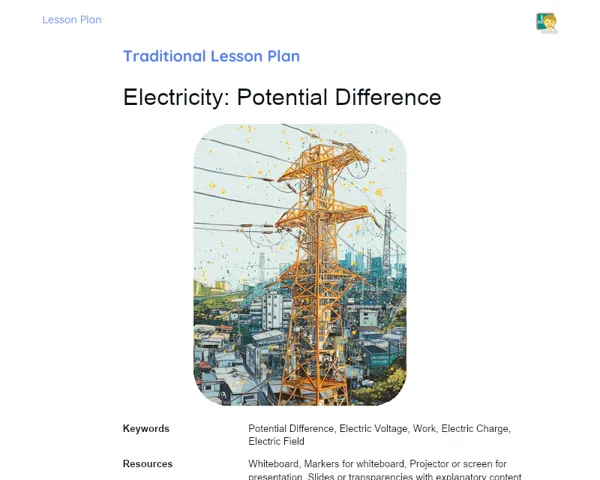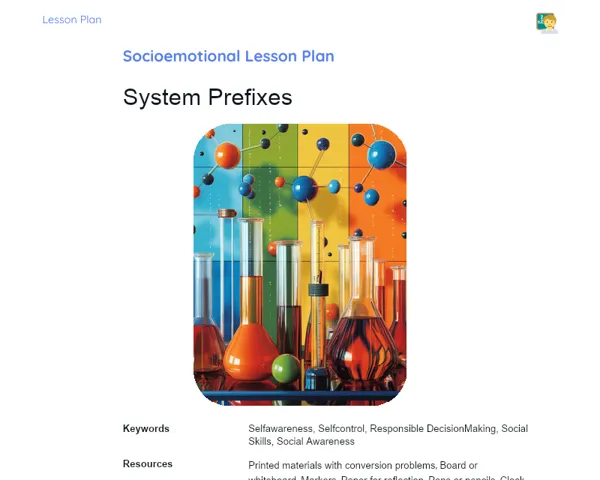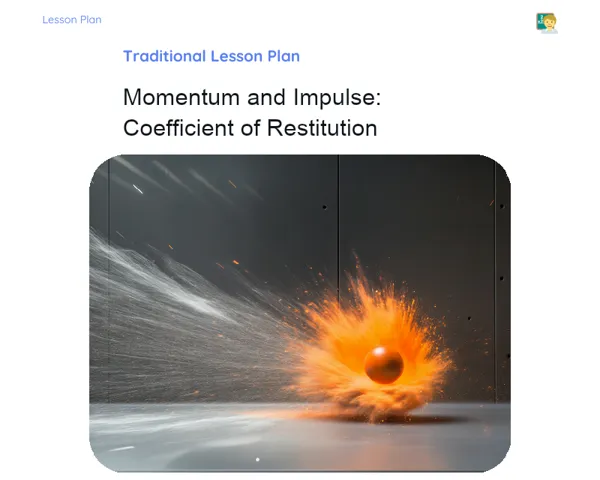Lesson Plan | Lesson Plan Tradisional | Electricity: Electric Potential Energy
| Keywords | Electric Potential Energy, Electric Field, Electric Charges, Potential Energy Formula, Electric Work, Conservation of Energy, Charge Speed, Practical Application, Numerical Examples, Electrical Devices, Lightning, Batteries, Capacitors |
| Resources | Whiteboard, Markers, Projector, Presentation Slides, Calculators, Notebooks, Pens, Exercise Sheets, Physics Textbooks |
Objectives
Duration: (10 - 15 minutes)
The aim of this stage is to provide a comprehensive overview of the lesson objectives, ensuring that students grasp the importance of understanding electric potential energy. This focus will direct students' attention to the key aspects of the content and prepare them for tackling related problems.
Objectives Utama:
1. Explain the concept of electric potential energy and its significance in electrical systems.
2. Demonstrate the calculation of electric potential energy for a charge within an electric field.
3. Teach the application of electric potential energy to determine the speed of a moving charge.
Introduction
Duration: (10 - 15 minutes)
The goal of this stage is to introduce students to the idea of electric potential energy in an engaging and clear manner, linking theoretical content to practical, everyday examples. This connection will ignite students' interest and make the learning experience more relevant and meaningful, preparing them for a deeper understanding of upcoming concepts.
Did you know?
Did you know that electric potential energy is what causes lightning during storms? The potential difference between clouds and the Earth generates a significant amount of electric potential energy, which is discharged explosively as lightning. Additionally, electric potential energy forms the basis of how batteries in our smartphones and laptops function, storing energy for later use.
Contextualization
To kick off the lesson on Electric Potential Energy, it’s essential to ground the concept within the context of Physics and electricity. Electric potential energy is a type of stored energy in a system resulting from the position of electric charges. This idea is similar to gravitational potential energy, where energy is stored based on an object's position in a gravitational field. For instance, envision an electric charge placed in an electric field, much like a ball perched on top of a hill; the potential energy is contingent on the charge's position in the field, just as gravitational potential energy depends on the ball's height. This concept is vital for understanding how electricity operates in everyday gadgets, such as batteries, capacitors, and electronic devices.
Concepts
Duration: (50 - 60 minutes)
This stage aims to deepen students' comprehension of electric potential energy through detailed discussions and practical examples. This approach will help them apply the concepts learned to solve specific problems, thereby solidifying their knowledge and facilitating the use of electric potential energy in calculating the speed of moving charges.
Relevant Topics
1. Concept of Electric Potential Energy: Clarify that electric potential energy is the energy stored due to the position of an electric charge in an electric field. Explain how this energy varies based on the charge's location and the strength of the electric field.
2. Formula for Electric Potential Energy: Present the formula U = k * (q1 * q2) / r, where U denotes electric potential energy, k is the electrostatic constant, q1 and q2 are the charges involved, and r is the distance between the charges. Clarify each component of the formula and their interrelations.
3. Relationship with Electric Work: Illustrate that electric potential energy converts into work when a charge shifts within the electric field. Explain that the work needed to move a charge from one location to another is equivalent to the change in electric potential energy between those two locations.
4. Conservation of Energy: Discuss the conservation of energy principle concerning the movement of charges in an electric field. Emphasize that the total energy (kinetic + potential) of a charge, when isolated in an electric field, remains constant in the absence of external forces.
5. Practical Application: Show how to compute the speed of a charge that starts at rest and transitions from its original position, using the conservation of energy principle. Present a numerical example to demonstrate the step-by-step process.
To Reinforce Learning
1. Calculate the electric potential energy between two charges of 3 µC and 5 µC separated by a distance of 0.2 meters in a vacuum.
2. A charge of 2 µC is shifted from point A to point B in an electric field. The difference in electric potential energy between these points is 4 mJ. What work is done on the charge?
3. A charge of 1 µC is released from rest where the electric potential energy is 10 mJ. What will be the speed of the charge upon reaching another point where the electric potential energy is 2 mJ? (Assume the mass of the charge is 2 mg).
Feedback
Duration: (20 - 25 minutes)
This stage is designed to ensure that students reinforce their understanding of electric potential energy by reviewing the detailed explanations of the solved questions and encouraging discussion and reflection on the topic. This approach aids in consolidating knowledge, addressing doubts, and linking theoretical content to practical, everyday contexts.
Diskusi Concepts
1. ✅ Question 1: Calculate the electric potential energy between two charges of 3 µC and 5 µC separated by a distance of 0.2 meters in a vacuum.
Solution: Formula: U = k * (q1 * q2) / r Where k = 8.99 x 10^9 N·m²/C² (electrostatic constant), q1 = 3 x 10^-6 C, q2 = 5 x 10^-6 C, and r = 0.2 m Substituting the values: U = 8.99 x 10^9 * (3 x 10^-6 * 5 x 10^-6) / 0.2 U = 8.99 x 10^9 * 15 x 10^-12 / 0.2 U = 674.25 x 10^-3 J U = 0.67425 J Result: The electric potential energy between the charges comes out to be 0.67425 joules. 2. ✅ Question 2: A charge of 2 µC is moved from point A to point B in an electric field. The difference in electric potential energy between the points is 4 mJ. What is the work done on the charge?
Solution: The work done on the charge equates to the difference in electric potential energy between the points. W = ΔU Where ΔU = 4 mJ = 4 x 10^-3 J Result: The work done on the charge is 4 mJ or 4 x 10^-3 joules. 3. ✅ Question 3: A charge of 1 µC is released from rest at a point where the electric potential energy is 10 mJ. What will be the speed of the charge when it reaches another point where the electric potential energy is 2 mJ? (Assume the mass of the charge is 2 mg).
Solution: Using conservation of energy: E_total = E_kinetic + E_potential Initial total energy (E_total_initial) = Initial potential energy (E_potential_initial) Final total energy (E_total_final) = Final kinetic energy (E_kinetic_final) + Final potential energy (E_potential_final) E_total_initial = E_total_final E_potential_initial = 10 mJ = 10 x 10^-3 J E_potential_final = 2 mJ = 2 x 10^-3 J ΔE_potential = E_potential_initial - E_potential_final = 8 x 10^-3 J ΔE_potential = E_kinetic_final E_kinetic_final = 1/2 * m * v² m = 2 mg = 2 x 10^-6 kg 8 x 10^-3 J = 1/2 * 2 x 10^-6 kg * v² v² = (8 x 10^-3 J) / (1 x 10^-6 kg) v² = 8 x 10³ v = √(8 x 10³) v ≈ 89.44 m/s Result: The speed of the charge will be approximately 89.44 m/s.
Engaging Students
1. 📌 Reflection Questions:
Why is electric potential energy significant in devices like batteries and capacitors? How does the conservation of energy apply to the movement of charges within an electric field? What other everyday occurrences can be explained using the concept of electric potential energy? What are the implications of a very high electric potential difference in natural systems, like thunderstorms? How can we connect the concept of electric potential energy to the work performed in an electrical system?
Conclusion
Duration: (5 - 10 minutes)
The purpose of this stage is to summarise and reinforce the key concepts discussed throughout the lesson, solidifying students' knowledge. Moreover, by illustrating the link between theory and practice and accentuating the relevance of the topic, the conclusion aids in solidifying understanding and showcasing the practical uses of the concepts learned, thereby nurturing a deeper and more meaningful comprehension.
Summary
['Electric potential energy refers to the energy stored based on the position of an electric charge within an electric field.', 'The formula for electric potential energy is U = k * (q1 * q2) / r.', 'Electric potential energy can convert into work provided a charge moves within the electric field.', 'The conservation of energy principle applies to charges’ movement in an electric field: the total energy (kinetic + potential) of an isolated charge remains constant when no external forces act upon it.', 'Practical applications of this concept include calculating the speed of a moving charge using the conservation of energy.']
Connection
This lesson connects theoretical concepts around electric potential energy to their practical applications, such as determining the speed of a moving charge. Detailed numerical examples and worked-out problems illustrated how theoretical ideas manifest in real-world scenarios within the realm of electricity.
Theme Relevance
Grasping electric potential energy is vital in daily life, as it is integral to various devices and natural events. For example, the energy stored in smartphone and laptop batteries is what empowers them, and electric potential differences lead to natural phenomena such as lightning strikes during storms. These instances underscore the practical significance and daily relevance of the subject.



